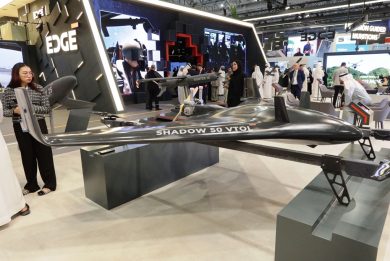
FEINDEF 2025 – International companies position themselves in Spain for the 6×6 armoured vehicles opportunities
At the Madrid defence exhibition more than one international player in the 6×6 armoured vehicles field announced agreements with local companies, to answer the requirement by the Ejercito de Tierra for a vehicle supporting the VCR (Vehículo de Combate sobre Ruedas), the 8×8 infantry fighting vehicle known as Dragón, under delivery by TESS Defence, the consortium that includes Escribano Mechanical & Engineering, General Dynamics European Land Systems – Santa Bárbara Sistemas, Indra and SAPA
The Dragon programme includes six versions of the 8×8 armoured vehicle: the VCI infantry fighting vehicle, the VEC cavalry reconnaissance vehicle, the VCZ, engineer combat vehicle, the VCPC battalion command post combat vehicle, the VCOAV forward observer combat vehicle, and the VREC recovery vehicle. Numerous roles remain to be covered, mortar carrier, CASEVAC/MEDEVAC, air defence/C-UAS, electronic warfare, and other. Hence the need to add to the Dragon a vehicle with similar mobility capable to fulfil all those support roles. The Spanish Army considered that a 6×6 platform would be sufficient, and as currently no such vehicle is being built in Spain, it is looking to the overall market to fulfil its need.
It was therefore not a surprise to see some foreign companies actively promoting their products and signing agreements with local companies, the higher the national content the greater the chances to win the bid.

Three months ago, at IDEX in Abu Dhabi, Escribano and Nimr, an EDGE company, signed a Memorandum of Understanding aimed at transferring the knowledge and experience necessary for the manufacture of these advanced vehicles in Spain. The realisation of that agreement could be seen on Day 2 of FEINDEF when Escribano the Ferox 6×6, a version of the Emirati company Jais 6×6. Should the team be assigned the contract by the Spanish MoD, the vehicle will be built in Linares, the nineth location of the Escribano group across Spain, the group increasing its diversification. The new facility “is going to be one of the most important since we’re going to have very significant industrial capabilities,” Javier Escribano, the president of EM&E Group underlined during the presentation.
“The agreement signed with Nimr provides for the transfer of knowledge and the progressive national industrialization of the vehicle, with design authority, thus reinforcing the technological sovereignty and productive fabric of the defence sector in Spain,” Fernando Fernández, the company CEO underlined adding that this will allow the company to adapt the vehicle to any of the needs expressed by Spanish forces. If the offer will succeed, the Ferox will be the first armoured vehicle ever built by the group. “From 2026 our facility in Linares will be able to produce eight vehicles per month, for a total of around 100 vehicles per year,” the CEO announced.
The Ferox will have a combat mass of 25,800 kg of which 4,000 kg of payload, while retaining a 1,200 kg growth capacity. It is powered by a 600 hp that is installed on the left of the vehicle, which allows the powerpack to be replaced in less than 40 minutes. Flexibility is the keyword, the Ferox being able to be transformed in many different variants thanks to its payload capacity and the fully transformable roof, the CEO stated.
At FEINDEF the Ferox 6×6 was exhibited with a Guardian 2.0 PRO remotely controlled turret, another of the new systems unveiled by the group at the Madrid event.

A second 6×6 was exhibited on the IFEMA premises; FNSS of Turkey was showcasing its PARS III 6×6. However, what really counted was the small model exhibited beside it; this was showing the 6×6 version of the most recent iteration of the PARS family, the PARS Alpha, which 8×8 version was unveiled at the World Defense Show 2024 exhibition in Riyadh. The model was fitted with a John Cockerill 3030 turret, this being available both in the two-man crew or in the unmanned version. Compared to the previously discussed Ferox, which is an MRAP-type of platform, the PARS family is designed to be a combat vehicle, which can obviously be also declined in several support variants.
According to information released, the four aforementioned companies intend to collaborate by providing expertise vehicle manufacturing and assembly, armoured vehicle design, optronic vehicle supply and manned turret assembly and integration. This aimed at offering to the Spanish Army a military on-the-shelf solution, including local integrated logistic support and lifecycle management. FNSS would obviously be the leading company for the platform while John Cockerill Defense is the turret expert. As for the two Spanish companies, TSD is active in the design, development, and manufacturing of military vehicles, while Groupo Oesía is specialized in dual-use digital and industrial engineering. TSD has an assembly line for tactical vehicles while Groupo Oesía is producing mission equipment and optronic sights, hence the two companies would ensure a high local content should the FNSS/John Cockerill proposal be selected.
Over years, FNSS have delivered various types and configurations of 6×6, an example of the PARS III 6×6 was exhibited in real at the Madrid exhibition, and 8×8 vehicles for domestic and export programs. Recently the company have successfully sealed the Turkish Land Forces New Generation Armoured Vehicles Program to deliver 6×6 and 8×8 PARS Alpha with four different configurations. It is to note that the model exhibited marked the first appearance of the PARS Alpha in the 6×6 version, which has been designed under the requirement of the Turkish Land Forces, and therefore will probably not be showcased in real until the service will not decide to do so.
Other competitors might well appear on the Spanish stage to answer the Ejército de Tierra 6×6 requirement.
Photos by P. Valpolini


